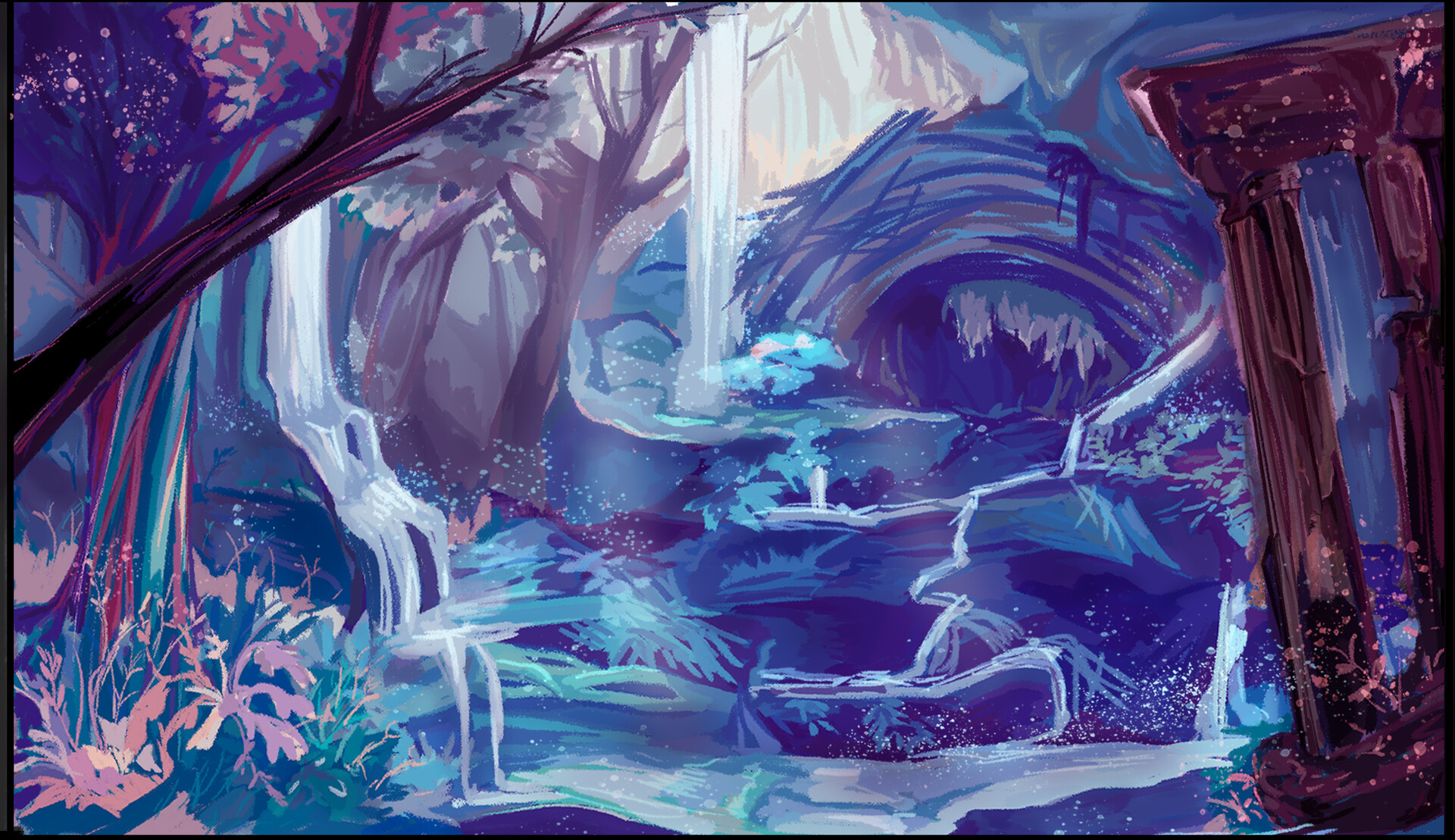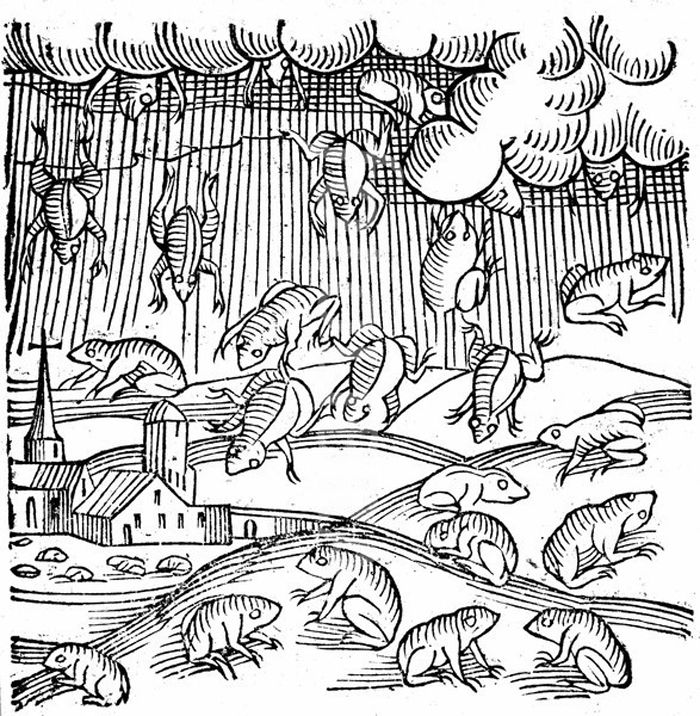Finding a magic system that does what I want is difficult. Not in the least because what I want from a magic system differs constantly depending on the sort of game I am (considering) playing.
However, one consistent ask that I have of magic is that it makes sense in the world, at least to me. So very gamey takes on magic, though they might be fun to play with, don't do it for me personally.
Other than 'making sense in the world' I wanted the magic for this game to feel like a genuine force of nature, rather than vague innate power. I think it worked pretty well, but we'll see when I test it at the open table game I run for my students if it actually works in practice.

How magic works:
- Magic is manifesting exceptions into the world.
- These exceptions (spells) are caught in dreams and powered by ambient chaos.
- Because magic is inherently chaotic, it is unstable and dangerous.
- Spells can be either cast, or bound into charms.
How spellcasting is resolved in game:
Each location has a limited amount of ambient chaos represented as a pool of d6s. The more exceptional/chaotic a location is, the more ambient chaos is present.
To cast a spell, grab a number of d6 from the regional pool equal to or below the amount your conduit allows for (if you do not use a conduit, your maximum amount of d6 is 1; casting without a conduit causes you to mutate).
1-3 is reduced effect (chaos is not consumed and returns to the location pool)
4-5 is full effect (chaos is consumed)
6 is explosive full effect (roll extra die from the pool if any remain)
Doubles cause fall-out. Resolve the spell as normal but the spell causes additional fallout depending on what the double is.
Triples are dooms. Resolve the spell as normal, but the spell harbinges the doom of its caster. Dooms progress from 1 to 3. The results of dooms might be resversable through adventure.
Each die counts. For example: I cast sleep with 3 dice and roll a 2, a 5
and a 4. This means I have 2x full effect and one reduced effect. I
would interpret this to mean that I can put 2 entities to sleep and make
one entity feel drowsy.
Smarter people than me over on Phlox's GLoG discord server have done the math for me, and the above system has the following odds:
1 die: >3% chance of fall-out or doom
2 dice: 26% chance of fall-out or doom
3 dice: 46% chance of fall out or doom
Those are some messy odds, which I like in theory, but we'll see how it works in practice.
How charms work:
- To make a charm you bind a spell to a physical vessel; the more chaos you invest, the stronger the bond, but the more volatile the charm becomes when stressed.
- When charms are put under extreme stress there is a chance they break. Physical damage will always destroy a charm.
- Charms are less flexible and less immediately impactful, but have effects that are always on and using charms is a lot more safe.
- Someone can only make the same charm once. If they break or lose it, they can't remake it.
How charms are resolved in game:
To bind a spell into a charm, grab a number of d6 from the regional pool equal to or below the amount your conduit allows for (if you do not use a conduit, your maximum amount of d6 is 1; binding without a conduit causes you to mutate).
Whenever a charm is put under extreme pressure roll the invested d6 and look at the highest die:
1-3 means the charm breaks
4-5 means the charm holds up
6 means the charm surges: it temporarily has increased effect; roll another d6 (for potential doubles and tripples)
Like with spell casting: Doubles cause fall-out and tripples cause dooms.
So for example: If you stand in a magical inferno wearing the flame repellent charm, I would rule it is put under high stress, and thus you have to roll the dice invested in the charm. For this example, let's say that 2d6 was investes in the charm, and you roll a 6 and a 5. The highest die is a 6, which means the charm surges and we roll another d6. We get a 4, so no doubles. The surge causes an increased effect, meaning a large area around the charm is now safe from the inferno and not just the wearer of the charm.
Dream Scholar: Spells, Fall-out, and Dooms
Spells
- Sleep/Drowsy
- Open/Unlock
- Levitate/Weightless
- Push/Shove
- Pull/Yank
- Silence/Muffle
- Invisibility/Camouflage
- Stop/Slow
- Light/Flash
- Fly/Jump
- Teleport/Portal
- Fireball/Ignite
The first word indicates the full effect, the second word the reduced effect.
Fall-out
- Chaos Reject: The next time you sleep you do not dream.
- Dream Leaks: You see or hear something that isn’t there.
- Draining Cast: You become incredibly tired, as if you haven't slept in a while.
- Missed Mark: The spell affects a random target rather than the one you intended.
- Cruel Fate: The spell has an inverse effect from the one you intended.
- Explode: The spell affects everyone in your vicinity rather than your intended target.
Dooms
- Half of your dreams are horrible nightmares during which you do not rest.
- A monstrosity from your nightmares escapes into the physical world.
- You fall into a never ending slumber.
Hidden Witch: Charms, Fall-out, and Dooms
Charms
- Lucky: The wearer of this charm is lucky. They can attempt very unlikely things and have more beneficial outcomes for as long as the charm lasts.
- Cursed: The wearer of this charm is unlucky. Their efforts either fail, or they succeed at a cost for as long as the charm lasts.
- Flame Repellent: Flames dare not touch the wearer of this charm for as long as it lasts.
- Cold Repellent: The cold dare not touch the wearer of this charm for as long as it lasts.
- Liquid Repellent: Liquids dare not touch the wearer of this charm for as long as it lasts.
- Unheard: The wearer of this charm cannot make any sound for as long as the charm lasts.
- Odourless: The wearer of this charm has no smell for as long as the charm lasts.
- Beauty: The wearer of this charm appears as beautiful to all who behold them by the standards of the beholder for as long as the charm lasts.
- Animal Friendship: The wearer of this charm makes favorable first impressions on animals.
- Darkness: This charm emits darkness, like a torch emits light for as long as it lasts. Casts anti-shadows when opaque objects are in the way.
- Healing: The wearer of this charm recovers more quickly than they normally would, for as long as the charm lasts.
- Smoking: This charm emits white smoke when in contact with air for as long as it lasts. Given enough time it can fill rooms of any size.
- Luminous: This charm emits light like a torch would for as long as it lasts. It does not produce heat.
- Anchor: The wearer of this charm cannot be moved against their will for as long as the charm lasts.
- Spying: You can observe the wearer of this charm whenever you want by looking into a mirror and saying their name for as long as the charm lasts.
- Lure: This charm smells irresistible to those who smell it, making them want to investigate the charm for as long as it lasts.
- Liquefying: The body of the wearer of this charm has the same properties as a stiff jello, meaning they are liquid, but not watery, for as long as the charm lasts.
- Illusion: This charm looks like whatever it is you want it to look like at the time for as long as it lasts. It doesn’t stand up to a physical examination.
- Mending: Rubbing this charm on tears and holes allows you to slowly mend them, for as long as the charm lasts.
- Wayfinding: This charm nudges towards whatever you are looking for. However, the cosmic forces that guide it are unaware of proper names of people or places.
Fall-out
- Inverse charm effect lingers upon the charm user as the charm pops out of existence.
- The charm turns into a vapour that spoils food and sours drink.
- Smoke billows from the charm as it burns, forming a cloud which causes impossible weather.
- The charm user starts to cackle uncontrolably everytime they open their mouth.
- Anything the charm user is wearing or carrying animates and is out for vengeance.
- People in the surge area mutate, objects randomly turn into something else entirely.
Dooms
- You can no longer bring life into this world. Plants and patients die in your care, children instinctually fear you.
- You've become an omen of bad luck. When you are near harvests fail, cows and chickens stop giving milk and eggs, and only monstrosities are born.
- Both life and death are unable to stand your presence. You turn into an aged husk, unable to die, but without the joys of life. No longer human: a outcast in every sense of the word.
Thoughts
What I like about this conception of magic as 1) powerd by ambient chaotic energy and 2) using spells from your dreams is that despite still being vague in the specifics, it gives us a frame of reference.
Chaos is like background radiation: under normal circumstances it is always there. Some places have increased chaos, either naturally occuring or because mages went and did a stupid.
If spells come from dreams, taking away access to dreams also takes away access to spells. Also, there is a precedent that things can come out of dreams, given enough chaos.
Another thing I think is a plus is that it allows for different casting traditions. Different schools of magic is a staple of fantasy, but often very little changes between them. They might cast different spells or use a different power source, but in effect spellcasting tends to be the same for every school of magic. That doesn't have to be bad, but it does seem a bit boring to me.
What is nice about magic working in really different ways between different magical traditions is that it gives the GM an out to put weird magical things in the world though up after the fact. It is sort of like a cheat to allow Into the Odd style arcana as well as more traditional casting without it feeling odd that there are all these weird cool things from the past, but despite having functioning magical traditions in the present no one seems to know how to make those cool things anymore.
An obvious drawback is that this increases the amount of systems you have to deal with. It makes the game more complex, and it might end up not even being worth the hassle.
This is probably fair, but to me the underlying mechanics are still mostly unified: Roll d6, 1-3 is undesireable in most cases, 4-5 is great, 6 risky but powerful. Avoid doubles and especially tripples.
Could it be slimmed down though? Probably, but I want to try this out to see where it actually runs into problems before making alterations.



No comments:
Post a Comment